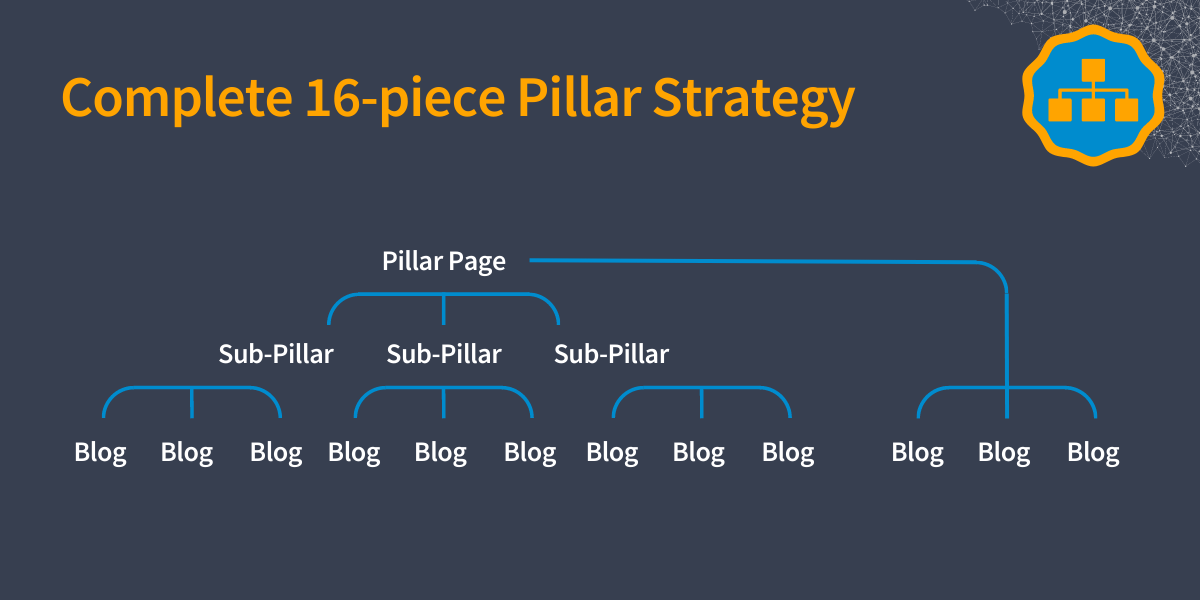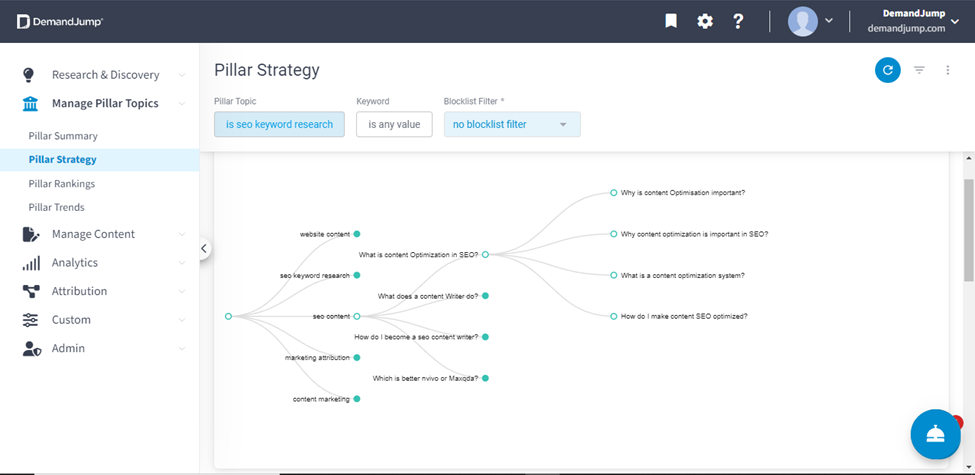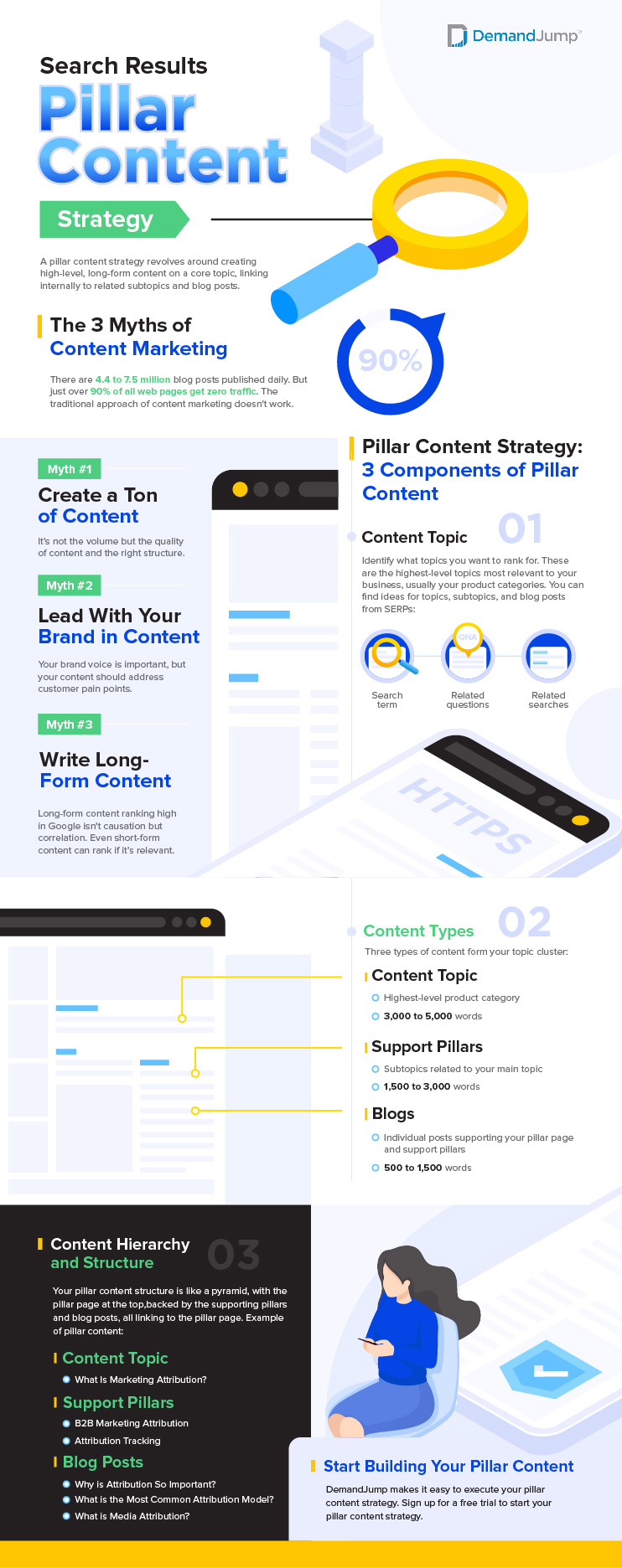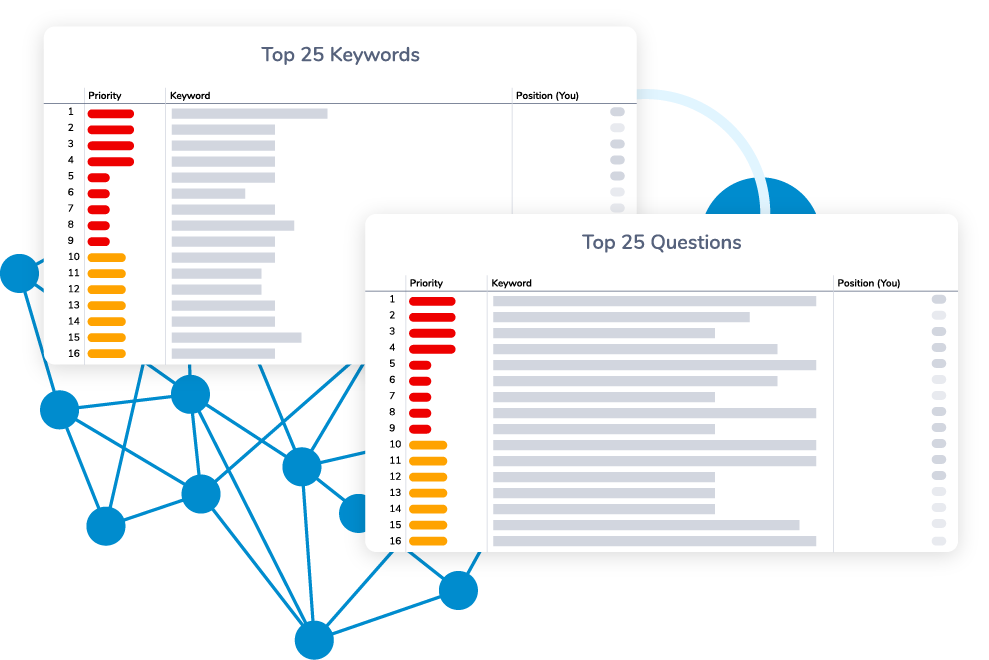Pillar-based marketing (PBM) is the newest cutting edge strategy in content marketing. If you’re a marketer or business owner, a content pillar is a concept you may already be familiar with. In a content pillar, the topic a business wants to be known for drives the strategy, guiding you to leverage your subject matter expertise, reinforce your brand values, and connect with prospective new customers.
A PBM content creation strategy expands on this idea and modernizes the outdated SEO businesses have historically used to succeed. In PBM, you’re still showcasing your subject matter expertise while also reintroducing the keyword data and audience behavior insights you need in order to understand and align to your ideal customers’ needs—and nothing else. Pillar-based marketing is gaining dominance because you get the best of both worlds, quickly driving your content to the top of search rankings while providing human value. How? Here’s everything you need to know to start winning page one search rankings in a matter of weeks.
What is a PBM Strategy?
A PBM strategy leverages highly-structured content networks on your website to capture organic traffic at the moment of search by recreating the network of search behavior surrounding Pillar topics on your website. This approach helps brands climb search engine results pages (SERPs) and capture the attention of their ideal customers. Here are the key elements of a PBM strategy.
PBM Strategy Template

- Pillar Page: A PBM strategy centers around a pillar page. This 3,000+ word piece of content is a high-level guide to the concept you want to rank for. Its title is usually a short-tail keyword of 2 or 3 words. But it’s important to choose the title based on audience behavior insights, not your expert perspective on the industry. While you know the jargon and technical terms inside and out, your audience may not. Without the right title to align with customer search behaviors, even the best-written, most amazing pillar page online will not attract traffic. In addition to the title, choose 15-20 high value keywords to include in your piece as the headlines and within your text. You’re actually reading a pillar page right now!
- Sub-Pillar Pages: The pillar page is a great start, but we want to help you get to the top of search rankings fast. That’s where sub-pillars come into play. These are 2,000+ word pieces of content which take deeper dives into your brand’s subject of authority. For each pillar page, you should have at least three sub-pillars. The titles of these pages are also likely to be short-tail keywords, but slightly more specific than the pillar at large. In fact, make sure to use the exact title of the pillar page within the introduction to each sub-pillar. Placing a backlink directly on this spot will send a signal to search engines that the pillar page is an authoritative resource on the topic. This is how we supercharge the content to climb the rankings!
A sub-pillar is shorter and more specific than a pillar page, but should include a similar number of keywords, around 15). Some of the most valuable keywords and questions might be repeated in the pillar and sub-pillar, while others will be unique. For instance, the sub pillars related to this pillar page you are currently reading are PBM strategy template, PBM marketing strategy, and PBM strategy examples. These will allow us to take deeper dives into the exact structure of a template, how PBM differs from other strategies, and some real-world examples of PBM success.
- Supporting Blogs: Supporting blogs serve a similar strategic function to sub-pillars, but are again more specific. A supporting blog is 750-1,000 words about a very focused topic. Usually, the title of the blog is an exact question your audiences are looking up online, and then the blog provides the answer.
There should be three supporting blogs which link directly and only to the pillar. Then, each sub-pillar should have three blogs which link to it as well as the pillar. Placing these links on the exact phrase which is the title of the pillar or sub-pillar lends those pages additional relevance in the eyes of search engines. In addition to those keywords, the blog should include 7-8 additional related keywords, with 4 or so “question” keywords as the headings of its different sections. Some of the supporting blogs for this pillar are “What is PBM Marketing?” and “What is a PBM tool?” It’s not that we won’t also answer these questions in the pillar and sub pillars, but when users are searching for exactly those questions, the blogs are more likely to win top SERP authority because they align with the language audiences are using, and their titles are longer-tail keywords that have less competition than the shorter-tail keywords that serve as the titles of pillar and sub-pillar pages.
- Call to Action: At the end of each piece, whether it’s as long as a pillar page or as short as a blog, you need a call to action. This is the action you ultimately want your target audience to take. It might be signing up for a free trial, scheduling a meeting with a sales rep, or making a purchase. Whatever it is, it should be introduced whenever possible as a page element outside of the body copy of your article; the only internal links your Pillar content pieces should contain should be the ones that point users to the sub-pillar and pillar pages higher up in the strategy. We also recommend using a headline to set your call to action apart, stating a value proposition of your brand or emphasizing one of your key differentiators in your market.
- Content Promotion: Believe it or not, publishing a content pillar with everything interlinked the way we explain is enough to get many keywords relevant to your pillar topic ranking on page one. But if you want to gain rankings even faster, driving traffic to your new content is a tried and tested approach. You can share it on social media, in email marketing, and through digital ads or a pay-per-click strategy, among other methods.
Why is this part of the organic strategy? Because search engines pay far more attention to how users engage with content to gauge content quality than they do the content itself. By sending qualified traffic to your new pillar content immediately, you’re giving search engines the opportunity to see that your ideal customers are finding what they’re looking for in your content, and therefore staying longer and engaging in other pages of your website. That, in turn, jumpstarts your content’s ability to rank higher for the terms you care about most.
As some the leading innovator of Pillar-Based Marketing, DemandJump has strategized, written, and published many content pillars for our clients and ourselves. Consistently, we’ve employed PBM best practices to earn businesses in a wide variety of industries page one rankings on the terms that drive their business forward.
One of the most common questions we get is about repetition of ideas within the pieces. What do you do when two sections in two different pieces are covering the same ideas? You should never use the same content verbatim, but you can certainly rinse and repeat the same ideas. We operate under the assumption that it’s a rare person who is going to read a pillar piece, the sub-pillar, and all the supporting blogs. That’s because the main way these pieces get found is through a web search. It’s also why it’s important for each piece to be self-contained and complete, including an awesome call to action.
While you want to keep variety within the pieces as much as possible, don’t fret too much if the main ideas are similar. After all, our goal here is to reinforce your brand authority and values–and those core concepts deserve repeating!
Why Do You Use PBM
Marketers use PBM because they want to create self-supporting written content that continues to climb the rankings week after week. Pillar-Based Marketing creates a content ecosystem on your website, with each new piece of content you publish on a topic lending SEO authority to your pillar page. All you have to do is insert backlinks to the pillar and sub-pillar and use the right keyword headlines for any new blog to become a fresh part of your PBM.
Especially in crowded market sectors, PBM is a way to organically win search rankings through high quality content. After initial launch and a few weeks of traction, the wins you gain through PBM can even empower you to restructure the marketing budget or perhaps change your spending in areas like pay-per-click.
Why does this work? Because PBM prioritizes optimizing content for the entire network of search behavior surrounding Pillar topics. Search engines know that users who are interested in the kinds of short-tail keywords that serve as Pillar topics also tend to go deeper in their searches, asking longer-tail questions and seeking more specific information. Rather than optimizing each article for a single keyword, which has traditionally been how marketers have been trained to operate, we think of each piece of content as part of a living, breathing network of content that always provides users the ability to go broader as they explore a topic.
This type of user experience—one that always points towards your website’s hub (your pillar page) on a given topic—is the one search engines respect because it mirrors the actual search behavior that’s happening in real time on the Internet.
What Types of Companies are Using PBM Successfully?
Pretty much any company doing digital marketing can use PBM successfully, especially with a free DemandJump account. Here are some high-level PBM campaign examples drawn from a few of the types of businesses and industry sectors we serve.
- Small Businesses and Startups: Small-but-mighty marketing teams use PBM to drive greater ROI from their investment in content creation.
- Fortune 500 Companies: Large, well-known brands use PBM to help different divisions of their business reach unique audience personas while attracting more clicks as the first organic search result. Did you know 94% of users scroll past the search ads and only click the top three organic search results?
- SaaS Companies: SaaS platforms use PBM to better-qualify their high value leads by helping audience members self educate during long buying cycles or during the period before a renewal. Having lots of different sub-pillars and blogs lets every stakeholder involved in the buying decision get their questions answered!
- Professional Services Companies: From property management to strategic planning, professional services companies in all market sectors use PBM to get their content in the top three search results, win clicks, and ultimately win business.
- eCommerce Companies: Online retailers often use the pillar page as a hub to educate about the differentiation between their products and others, as well as to list popular products in one place for easy browsing.
Did these PBM use cases get your wheels turning? Time to talk about how it’s done.
How Do I Get Started With PBM?
Getting started with PBM is as simple as creating a free DemandJump account. To date, DemandJump is the only platform designed specifically to empower marketers to research, build, and deploy Pillar-Based Marketing strategies. Here’s how it works:
Creating your free DemandJump account takes less than 3 minutes. Along the way, you’ll be prompted to enter what you have in mind as a potential pillar topic.
Next, as part of your account setup, you will also enter the web URLs for some of your competitors. We recommend adding at least three. Don’t worry–you can change them later if you want. And if there are other websites you don’t know about dominating the SERPs you want to win, we will let you know who they are.
Once you’ve set up your account, you’ll be in the DemandJump platform waiting for your first insight report to generate. This can take a few minutes–there’s a lot of data to collect for you!
When the Insight Report is complete, it will be translated into a Topic Summary. This tells you the top 25 keywords users are searching for related to your topic, as well as the top 25 questions they are asking. The “Keywords and Positions” section will contain a longer list of keywords beyond 25 if you want to see more options.
Your topic summary might be right in line with your services, products, and user personas. Or, you might learn that the potential pillar topic you had in mind isn’t the best fit after all. In that case, just run another Topic Summary from the home page! You can run as many as you like with a free account.
Once you know the exact pillar topic you want to target, you can skip a lot of strategic work by unlocking one of DemandJump’s premium features. The Pillar Strategy feature shows you multiple options for sub-pillar topics that will add major oomph to the pillar page. With one more click, you’ll also see the supporting blogs you should write to round out the content cluster.

If you unlock the custom PBM strategy, you’ll get more suggestions for sub-pillars and blog topics than you need to launch the strategy. Narrow these down based on your ideal customer profile, your subject matter expertise, and your business goals. You can always keep some in mind to use later when you scale up the PBM strategy!
Without the custom strategy feature unlocked, here’s what we recommend. Choose three short keyword phrases of 3-5 words from your top 25 as your sub-pillars. Heck, if it’s possible, choose from the top five so you know you’re targeting the most popular search terms! Then, use the top 25 questions to give titles to your supporting blogs.
A Content Brief is a great way to get a quick analysis of what needs to be covered in each piece of content. Type the title of the pillar, sub-pillar, or blog into the bar on the Home page to generate the Content Brief. You’ll be able to delete the keywords you don’t want to include and keep the ones you do. Then, transfer your custom outline into the word processor of your choice with a simple copy and paste.
Each user gets one content brief included with a free account. If you don’t want to unlock more, you can use the “Keywords and Positions” section to see the keywords and make an outline.
Now that you’ve identified the topic for your PBM campaign, the titles for your content, and the headlines you need to use, start writing!
How Do I Run a Successful PBM Campaign?
Running a successful PBM campaign starts with publishing the entire campaign at once. That means the pillar, the three sub-pillars, and at least three supporting blogs for the pillar and each sub-pillar. This sends a huge signal to search engines that you are speaking to the topic you want to win. You can add more sub-pillars and supporting blogs as the pillar is published and starts to perform. We also see customers and our agency partners winning success by upgrading lower-performing content to replace and update keywords, or even combining multiple low-ranking blogs into one SEO-optimized sub-pillar.
What Makes a PBM Campaign Successful?
One thing that makes a PBM campaign successful is choosing the right keyword titles for the pillar page, sub-pillars, and supporting blogs. We strongly advise using a DemandJump Insight Report for this function to eliminate the guesswork and hours of research. Each of our Insight Reports contains data which a human would have to read for 1,000 hours or more to unpack!
The second factor in a successful PBM campaign is identifying the right competition. Within each Insight Report, you see not only how your own site is ranking, but how your competitors are ranking as well. This lets you create a custom strategy. If you want to go after the same topics? Great! Or, you can chart your own path and target different keywords to win in a different way.
The third essential component for a successful PBM campaign is real-time audience behavior insights. The keywords which audiences are using when you launch the campaign are likely to change as trends change. Also, as your pages rank higher, users might start asking different and more specific questions because your original content was so darn useful. Having a one-stop resource to see what keywords and questions users are searching for today lets you create the best content today. Next week, if that changes, we’ll be there to help you adapt and meet users where they want to be.
How Can Marketers Scale a PBM Campaign Successfully?
Scaling your PBM campaign happens a few weeks or months after the initial campaign is published. By then, you will have plenty of insights into which pages are already performing well and which ones could use more support. You can then upgrade content as we discussed earlier, or add new sub-pillars and supporting blogs which speak to different search terms and trends you see in the Topic Summary.
We recommend the 16-piece Pillar Strategy—1 pillar page, 3 sub-pillar pages, and 3 supporting blogs linking up to each of those first four pieces—only as a starting point because we’ve seen that this structure is the minimum amount to create the network effect on your website. The immediate results from launching these initial pieces are often remarkable enough to gain the support of key stakeholders to invest further in the strategy. Depending on how competitive your chosen pillar topic is, you may need many more; we’ve produced pillar strategies that contain up to 130 pieces of content for particularly competitive terms!
What Are Some PBM Tactics?
Here are some advanced PBM tactics straight from DemandJump’s awesome content team! Use these to take your PBM campaign ideas to the next level.
- Choose High-Value Questions as H2s: In your Insight Report, you’ll see the top 25 questions associated with the search term you want to rank for. Using these as the headlines in your pillar page gives you a confident direction you know will address what your audience is searching for.
- Diversify Your Introductions and Structure: Even if you are writing to a very niche topic, you can still add variety to your sub-pillars and supporting blogs with unique, compelling introductions. Consider opening with a question, statistic, or quote to keep things fresh.
- Run Weekly Insight Reports: Perform a “pillar check up” each week by running an Insight Report on your pillar page title. This lets you see how rankings are improving and what new questions or keywords you can target next. The “DJ Score” lets you know how high priority a keyword should be. Anything 80 or higher is worth serious consideration! The best part? When you select a topic as one of your brand’s pillars, DemandJump automatically updates that topic’s insight report every week.
- Use Branded Keywords Strategically: If you’re trying to break into a market, some of the keywords might include the brand names or product names of your competitors. After all, the network of search behavior around a topic you want to rank for very well might include branded terms since what DemandJump shows you is the real world of actual search behavior. While you don’t necessarily want to write a whole pillar page about your competitor’s product, you can still use these keywords to win organic traffic away from the competition. These keywords can be used to draw in traffic and then redirect their attention to your brand and values. For instance, you can use branded keywords in a headline to set up a comparison between your company and theirs. If users have questions about how to use a competitor’s platform, you can share an explanation while also describing why using your company is better and easier! You don’t have to go negative–just go with the truth.
If even these insights seem basic, then you might be ready for PBM certification courses!
What is THE Example of PBM? DemandJump!
DemandJump is so enthusiastic about PBM because it has worked for us and our customers. Here are some of the amazing results we’ve seen our users achieve, and achieved ourselves:
- 268% increase in revenue and 242% increase in ad spend ROI! (Chef Camp)
- 170% increase in revenue in less than one year! (ePlanters)
- 91 first page search rankings in less than five months! (DemandJump)
Believe us–it’s time to take the guesswork out of your SEO strategy and start winning SERPs through pillar-based marketing. Sign up for a free account to get started doing it yourself, or join DemandJump University to learn our methods and achieve wins even faster. However you need us to help, we are here for you!
















